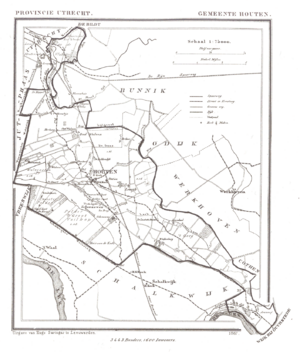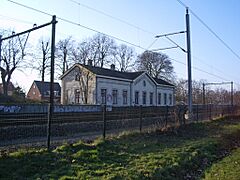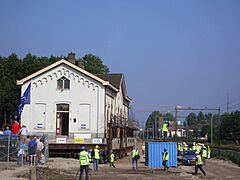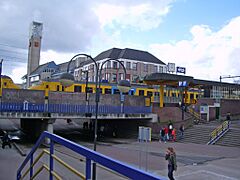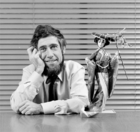Houten facts for kids
Quick facts for kids
Houten
|
|||
|---|---|---|---|
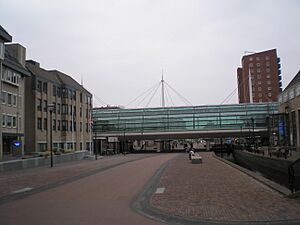
Town hall and station in Houten
|
|||
|
|||

Location in Utrecht
|
|||
| Country | Netherlands | ||
| Province | Utrecht | ||
| Government | |||
| • Body | Municipal council | ||
| Area | |||
| • Total | 58.99 km2 (22.78 sq mi) | ||
| • Land | 55.41 km2 (21.39 sq mi) | ||
| • Water | 3.58 km2 (1.38 sq mi) | ||
| Elevation | 2 m (7 ft) | ||
| Population
(May 2014)
|
|||
| • Total | 48,471 | ||
| • Density | 875/km2 (2,270/sq mi) | ||
| Time zone | UTC+1 (CET) | ||
| • Summer (DST) | UTC+2 (CEST) | ||
| Postcode |
3990–3999
|
||
| Area code | 030 | ||
Houten is a special town in the Netherlands, located in the province of Utrecht. It's known for its smart design, especially how easy it is to get around by bike. Houten is a great example of a modern town that still cares about its history and the environment.
Contents
Discover Houten: A Special Dutch Town
Houten is more than just one town; it's a municipality, which is like a local government area. This area includes a few smaller towns and villages.
Exploring Houten's Communities
The Houten municipality is made up of these places:
- 't Goy
- Houten (the main town)
- Schalkwijk
- Tull en 't Waal
Houten: The Main Town
The biggest town in the area is also called Houten. It's a "commuter town," meaning many people who live here travel to work in bigger cities nearby, like Utrecht, which is about 9 kilometers (5.6 miles) away. In 2020, the town of Houten had over 50,000 residents. It's a busy and growing place!
Journey Through Houten's History
Houten has a long and interesting past, with roots stretching back to Roman times.
Uncovering Ancient Roots
Did you know that parts of a Roman villa were found right in Houten's old town? These ancient remains were discovered in the 1950s and you can still see hints of them in the street patterns today.
In the Dark Ages, Houten started to grow as a farming community. The area was divided into different "districts" called gerechten. Some of these old names, like Schonauwen and Wulven, are still used today.
Historic Buildings and Landmarks
Many buildings in Houten show its long history. In the old town, called Het Oude Dorp (The Old Town), you'll find two important churches: the Roman Catholic Church (built in 1884) and the Protestant Church (built in 1563). The older church has parts that might be from the 11th century!
Another famous spot is De Engel ("The Angel"), a restaurant-cafe that was a tavern way back in the 16th century. Old roads like the Odijkseweg and Loerikseweg also remind us of Houten's past. While Houten used to have many fruit orchards, only a few remain today.
How Houten Grew: Modern Expansion
Modern Houten really started to take shape in the late 20th century, between 1966 and 1998. It was chosen as a "growth center" (Groeikern) to help with the increasing population of Utrecht.
A special urban planner named Robert Derks helped design the new town. In 1979, they started building 10,000 new homes. This caused Houten's population to jump from 4,000 to over 30,000 by the year 2000!
Continued Growth in Houten-Zuid
Houten kept growing! From 1992 to 2015, about 7,000 new houses were built in Houten-Zuid (South Houten). This new area followed similar design ideas as the older northern part, but with some cool differences.
For example, Houten-Zuid has a much larger body of water. It also has a unique five-sided green area in its center, different from the long, straight green zones in Houten-Noord. In some places, cars and bikes even share the road, a concept that was later used in the northern part too.
Getting Around: Transport in Houten
Houten is famous for its excellent transport system, especially for bikes!
Rail Travel
Houten has two train stations: Houten and Houten Castellum. These stations connect Houten to Utrecht in the north and Geldermalsen in the south. From Geldermalsen, you can catch trains to other cities like Tiel and 's-Hertogenbosch.
The railway tracks were even doubled from two to four to allow for more trains and the new Castellum station. Now, four trains per hour travel in each direction!
Bus Connections
Buses in Houten can take you to nearby towns and cities, including Nieuwegein and Utrecht.
Cycling: Houten's Superpower
Like many Dutch cities, Houten is amazing for cyclists. But Houten is special because it was designed with bikes in mind! It has car-free public spaces and a huge network of bike paths. This means cyclists and walkers are kept separate from car traffic, making it super safe and comfortable to ride a bike.
Cycling is the most popular way to get around town. Houten has even won the title of Fietsstad (BikeCity) of the Netherlands twice, in 2008 and 2018! No other city has done that. People from all over the world visit Houten to learn about its amazing bike-friendly design.
Car Access
Houten has its own exit from the A27 motorway to the west. There's also a road (N409) that connects Houten to Nieuwegein. To the east and south, you'll find local roads, not big highways.
One cool thing about Houten's design is its "ring road." This road circles the entire town, so cars have to use it to get from one part of Houten to another. This keeps traffic out of the quiet neighborhoods, making them safer and more peaceful.
Houten's Smart Design and Buildings
Sustainable City Planning
Houten is known worldwide for its clever city design. The way the city is built encourages people to use bikes and trains instead of cars. This helps the environment and keeps people active!
Some great things about Houten's design include how easy it is to reach the train station, the many green spaces and water areas, and lots of sports fields. It's also considered one of the safest cities in the Netherlands. The separate paths for bikes and cars mean fewer accidents.
Houten also has special places like Thomas House, a small housing complex opened in 2013 for adults with intellectual disabilities.
Notable Buildings in Houten
Houten has some really cool and unique buildings:
- The Aluminiumcentre, also called Aluminium wood
- Het Domein, a pyramid-shaped apartment complex
- The Total petrol station, with a unique design
- The Fire department building
- De Kniphoek at Rietplas, known for its traditional style houses
- The Golden House
- The railway station bicycle transferium, a special place for bikes at the station
- JOINN!
Famous People Connected to Houten
Many interesting people have lived in or come from Houten:
- Bart de Ligt (1883–1938): A Dutch anarcho-pacifist who supported people who refused to fight in wars. He was from Schalkwijk.
- Chriet Titulaer (1943–2017): A Dutch astronomer and TV presenter who lived in Houten.
- Branimir Štulić (born 1953): A singer-songwriter and musician from the rock group Azra, who lives in Houten.
- Peter van Dalen (born 1958): A Dutch politician and a member of the European Parliament.
- Ruud Kuijer (born 1959): A Dutch sculptor known for his "Water works." He was born in Schalkwijk.
- Bram Snepvangers (born 1976): A professional player of the card game Magic: The Gathering, who lives in Houten.
- Rutger Bregman (born 1988): A Dutch historian and author, famous for his book Utopia for Realists. He lives in Houten.
- Noël van 't End (born 1991): A Dutch judoka who competed in the 2016 Summer Olympics.
See also
 In Spanish: Houten para niños
In Spanish: Houten para niños



